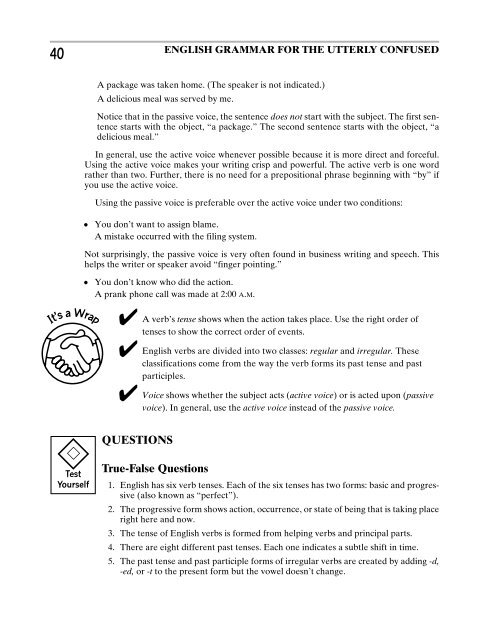EN - English Grammar for the Utterly Confused.pdf
EN - English Grammar for the Utterly Confused.pdf
EN - English Grammar for the Utterly Confused.pdf
- No tags were found...
You also want an ePaper? Increase the reach of your titles
YUMPU automatically turns print PDFs into web optimized ePapers that Google loves.
40<strong>EN</strong>GLISH GRAMMAR FOR THE UTTERLY CONFUSEDA package was taken home. (The speaker is not indicated.)A delicious meal was served by me.Notice that in <strong>the</strong> passive voice, <strong>the</strong> sentence does not start with <strong>the</strong> subject. The first sentencestarts with <strong>the</strong> object, “a package.” The second sentence starts with <strong>the</strong> object, “adelicious meal.”In general, use <strong>the</strong> active voice whenever possible because it is more direct and <strong>for</strong>ceful.Using <strong>the</strong> active voice makes your writing crisp and powerful. The active verb is one wordra<strong>the</strong>r than two. Fur<strong>the</strong>r, <strong>the</strong>re is no need <strong>for</strong> a prepositional phrase beginning with “by” ifyou use <strong>the</strong> active voice.Using <strong>the</strong> passive voice is preferable over <strong>the</strong> active voice under two conditions:●You don’t want to assign blame.A mistake occurred with <strong>the</strong> filing system.Not surprisingly, <strong>the</strong> passive voice is very often found in business writing and speech. Thishelps <strong>the</strong> writer or speaker avoid “finger pointing.”●It’s a WrapYou don’t know who did <strong>the</strong> action.A prank phone call was made at 2:00 A.M.✔ A verb’s tense shows when <strong>the</strong> action takes place. Use <strong>the</strong> right order oftenses to show <strong>the</strong> correct order of events.✔ <strong>English</strong>✔ Voiceverbs are divided into two classes: regular and irregular. Theseclassifications come from <strong>the</strong> way <strong>the</strong> verb <strong>for</strong>ms its past tense and pastparticiples.shows whe<strong>the</strong>r <strong>the</strong> subject acts (active voice) or is acted upon (passivevoice). In general, use <strong>the</strong> active voice instead of <strong>the</strong> passive voice.TestYourselfQUESTIONSTrue-False Questions1. <strong>English</strong> has six verb tenses. Each of <strong>the</strong> six tenses has two <strong>for</strong>ms: basic and progressive(also known as “perfect”).2. The progressive <strong>for</strong>m shows action, occurrence, or state of being that is taking placeright here and now.3. The tense of <strong>English</strong> verbs is <strong>for</strong>med from helping verbs and principal parts.4. There are eight different past tenses. Each one indicates a subtle shift in time.5. The past tense and past participle <strong>for</strong>ms of irregular verbs are created by adding -d,-ed, or -t to <strong>the</strong> present <strong>for</strong>m but <strong>the</strong> vowel doesn’t change.
















